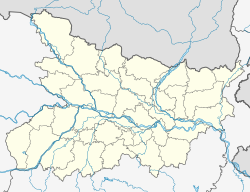Maner, Bihar
Maner
मनेर Maner Sharif | |
|---|---|
Town | |
 The Bari Dargah (Tomb of Shah Daulat), a major Sufi shrine | |
| Nickname: The Land of Sufi Saints | |
| Coordinates: 25°39′N 84°53′E / 25.65°N 84.88°E | |
| Country | |
| State | Bihar |
| District | Patna |
| Historical significance | 8th–17th century CE |
| Government | |
| • Body | Nagar panchayat |
| Area | |
• Total | 12.5 km2 (4.8 sq mi) |
| Elevation | 54 m (177 ft) |
| Population (2011) | |
• Total | 26,912 |
| • Density | 2,200/km2 (5,600/sq mi) |
| Languages | |
| • Official | Hindi, Urdu, Magahi |
| Time zone | UTC+5:30 (IST) |
| Area code | 0612 |
| Vehicle registration | BR-01 |
| Website | patna |
Maner, also known as Maner Sharif, is a historic town and a block in Patna district of Bihar, India. Situated approximately 24 km west of Patna on NH-922, it is renowned for its Mughal-era dargahs and as an important Sufi pilgrimage center.
Etymology
[edit]The ancient name of Maner was Maniyar Mathan, meaning "musical city" in local tradition. The suffix "Sharif" (meaning noble) was added due to its association with Sufi saints.
History
[edit]A now-lost copper plate grant found at Maner, dated to 11 May 1124, indicates that Maner was the seat of a paṭṭalā (district) at that time. The grant records that the Gāhaḍavāla king Govindachandra donated two villages called Guṇāve and Paḍalī, both in the paṭṭalā of Maṇiari (i.e. Maner), to a brāhmaṇa named Gaṇeśvaraśarman. The villages of Guṇāve and Paḍalī were presumably located somewhere near Maner, but their exact locations are unknown.[1]
Later, Maner gained prominence during the medieval period as a center of Sufism:
- 13th century: Became associated with Sufi saint Makhdoom Yahya Maneri
- 1608: Death of Makhdoom Shah Daulat, another prominent Sufi saint
- 1616: Construction of Bari Dargah (Great Shrine) by Ibrahim Khan Kakar, the Mughal governor of Bihar
- 1619: Construction of a mosque by Ibrahim Khan
The town flourished as a center of Islamic learning during the Mughal period.
Geography
[edit]Maner is located at 25°39′N 84°53′E / 25.65°N 84.88°E on the southern bank of the Ganges river. The Son River meets the Ganges at Haldi Chhapra near Maner.
Climate
[edit]Maner has a Humid subtropical climate (Köppen Cwa) with:
- Hot summers (April–June)
- Monsoon rains (July–September)
- Mild winters (November–February)
Demographics
[edit]As of the 2011 census:
- Population: 26,912
- Gender ratio: 947 females per 1000 males
- Literacy rate: 71.12% (higher than state average)
- Major languages: Magahi (94.24%), Hindi (5.76%)
Administration
[edit]Maner is a community development block consisting of 38 villages. It is part of the Maner Assembly constituency and Pataliputra Lok Sabha constituency.
Landmarks
[edit]Religious sites
[edit]- Bari Dargah: Tomb of Shah Daulat (1616), fine example of Mughal architecture
- Chhoti Dargah: Tomb of Makhdoom Yahya Maneri
- Haldi Chhapra: Confluence of Son and Ganges rivers
- Maner Jain Temple: Ancient Jain pilgrimage site
Other attractions
[edit]- Maner Fort: Ruins of an ancient fort
- British-era bridge over Son River
Culture
[edit]Festivals
[edit]- Urs: Annual festival at the dargahs attracting thousands
- Chhath Puja: Celebrated at Haldi Chhapra ghat
Cuisine
[edit]- Maner ka Laddu: Famous sweet made with ghee and chhana
- Traditional Bihari dishes: Litti chokha, Khaja, Thekua
Economy
[edit]Maner's economy is primarily based on:
- Agriculture (rice, wheat, maize)
- Small-scale industries
- Religious tourism
The town is famous for its sweet shops, particularly Maner Sweets established in 1935.
Transport
[edit]- Road: Connected via NH-922 to Patna and Arrah
- Rail: Nearest station is Danapur (20 km)
- Air: Jay Prakash Narayan International Airport (30 km)
Education
[edit]Notable educational institutions:
- Ram Nagina Singh Inter College (established 1948)
- Government Girls High School
- Maner College (affiliated to Patna University)
Notable people
[edit]- Kunal Singh - Bhojpuri actor
- Ramayan Tiwari - Bollywood actor
References
[edit]- ^ Majumdar, N. G. (1922). "Maner Copperplate of Govindacandra, V. E. 1183". Journal of the Asiatic Society of Bengal. XVIII: 81–4. Retrieved 10 June 2025.

